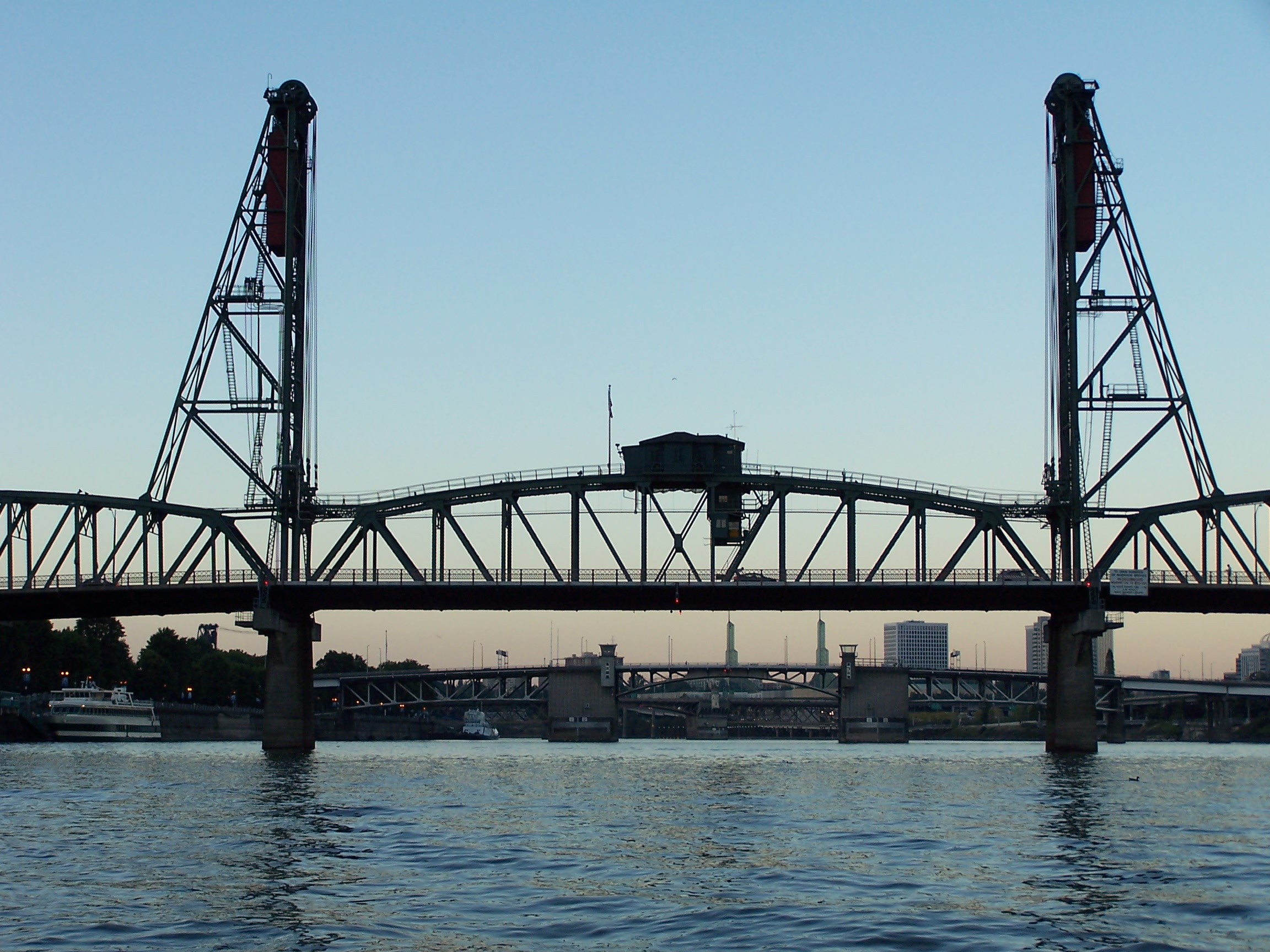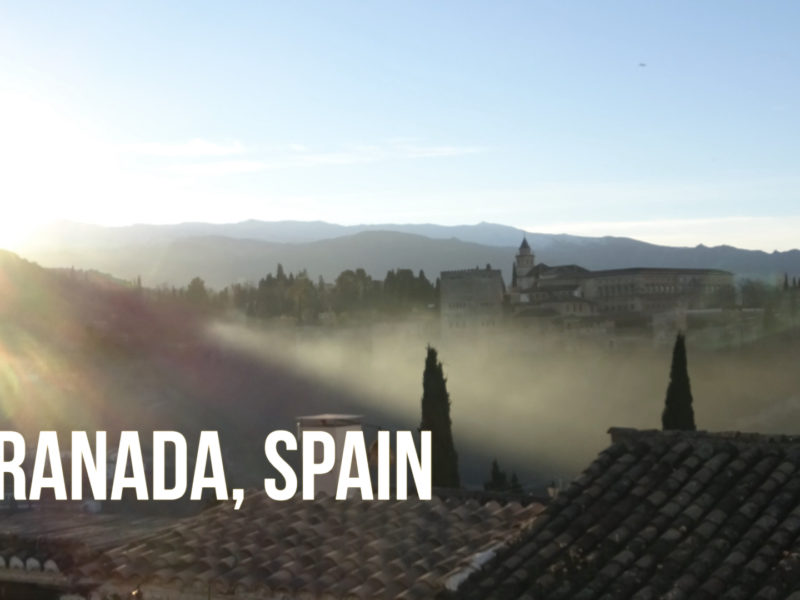Update Jan 2021: Watch our new video above for more information and a bonus bridge!
Portland is lucky to be home to a nice collection of historic bridges, along with a very modern one. While many people may not even notice the bridges as they cross them, several Portland bridges deserve a closer look. Many of the cities bridges are clustered in the downtown area, so it isn’t that difficult to see them up close and personal. Those that are a little further from the downtown core have enough interest to make a little side trip worthwhile.
Oregon City Arch Bridge
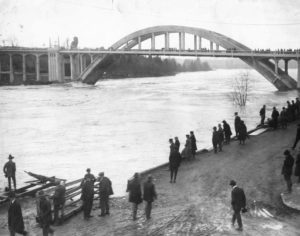 The only bridge on the list that isn’t technically in Portland, the Oregon City Arch Bridge spans the Willamette River just downstream from Willamette Falls. Built in 1922, the bridge has served as the main access road into downtown Oregon City for almost a century. This bridge, though, is also special because it is the only Portland-area bridge built by Conde McCullough, the mastermind behind the Oregon Coast bridges that completed the missing links of Highway 101. The Oregon City Bridge was only his second, but already his signature Art Deco touches, like the pylons at the entrance to the span, were a part of the design.
The only bridge on the list that isn’t technically in Portland, the Oregon City Arch Bridge spans the Willamette River just downstream from Willamette Falls. Built in 1922, the bridge has served as the main access road into downtown Oregon City for almost a century. This bridge, though, is also special because it is the only Portland-area bridge built by Conde McCullough, the mastermind behind the Oregon Coast bridges that completed the missing links of Highway 101. The Oregon City Bridge was only his second, but already his signature Art Deco touches, like the pylons at the entrance to the span, were a part of the design.
Tilikum Crossing
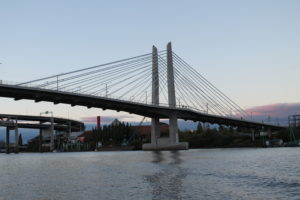 The first major bridge in the U.S. to be built solely for use by public transportation and bike/pedestrian traffic (no private vehicles are allowed), the Tilikum Crossing, Bridge of the People is Portland’s newest bridge, opening in 2015. The main impetus to build a new bridge across the Willamette River was to provide a crossing for the new MAX Orange Line and Portland Streetcar routes. It also filled a need for a traffic-free crossing for several bus lines, which were increasingly getting stuck on the Ross Island Bridge. The result is a beautiful cable-stayed bridge which is a pleasure to cross on foot, due to the lack of fast-moving traffic.
The first major bridge in the U.S. to be built solely for use by public transportation and bike/pedestrian traffic (no private vehicles are allowed), the Tilikum Crossing, Bridge of the People is Portland’s newest bridge, opening in 2015. The main impetus to build a new bridge across the Willamette River was to provide a crossing for the new MAX Orange Line and Portland Streetcar routes. It also filled a need for a traffic-free crossing for several bus lines, which were increasingly getting stuck on the Ross Island Bridge. The result is a beautiful cable-stayed bridge which is a pleasure to cross on foot, due to the lack of fast-moving traffic.
Hawthorne Bridge
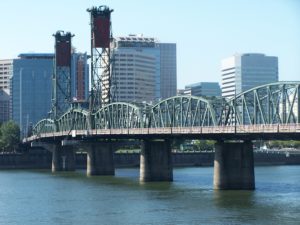 The Hawthorne Bridge is the oldest bridge in Portland, and the oldest vertical lift bridge in the United States. The center span lifts straight up to allow for about 150 feet of clearance for river traffic. The bridge connects the heart of downtown Portland to the Central Eastside Industrial area. A renovation in 1998-9 added additional lanes for pedestrian and bicycle traffic. This addition helped make the Hawthorne the most popular bridge for bicyclists in the city. It is one of the best bridges to walk across in the city, with fantastic views of downtown Portland, the inner east side and many of the other Willamette River bridges.
The Hawthorne Bridge is the oldest bridge in Portland, and the oldest vertical lift bridge in the United States. The center span lifts straight up to allow for about 150 feet of clearance for river traffic. The bridge connects the heart of downtown Portland to the Central Eastside Industrial area. A renovation in 1998-9 added additional lanes for pedestrian and bicycle traffic. This addition helped make the Hawthorne the most popular bridge for bicyclists in the city. It is one of the best bridges to walk across in the city, with fantastic views of downtown Portland, the inner east side and many of the other Willamette River bridges.
Steel Bridge
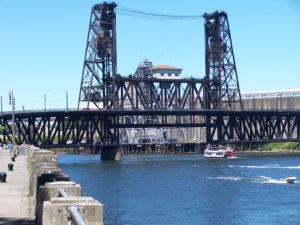 Connecting the north end of the downtown core to the Rose Quarter/Convention Center area, the Steel Bridge stands as the second-oldest vertical lift bridge in the United States (just behind the Hawthorne Bridge). The Steel Bridge, however, has an additional twist: double decks. The lower deck sits about 25 feet above the river, carrying the Union Pacific railroad tracks (and newly-added bike/pedestrian lanes). Above, an upper deck carries regular auto traffic, as well as the MAX train. The lower deck can be raised independently, allowing smaller river traffic to pass without disturbing traffic on the upper deck. Both decks can be raised together for taller vessels. It is the only double-deck bridge in the world with independently operating lifts. The bridge is one of the most multi-modal bridges in the country, carrying freight trains, Amtrak passenger trains, light-rail trains, buses, cars, trucks, bicycles and pedestrians.
Connecting the north end of the downtown core to the Rose Quarter/Convention Center area, the Steel Bridge stands as the second-oldest vertical lift bridge in the United States (just behind the Hawthorne Bridge). The Steel Bridge, however, has an additional twist: double decks. The lower deck sits about 25 feet above the river, carrying the Union Pacific railroad tracks (and newly-added bike/pedestrian lanes). Above, an upper deck carries regular auto traffic, as well as the MAX train. The lower deck can be raised independently, allowing smaller river traffic to pass without disturbing traffic on the upper deck. Both decks can be raised together for taller vessels. It is the only double-deck bridge in the world with independently operating lifts. The bridge is one of the most multi-modal bridges in the country, carrying freight trains, Amtrak passenger trains, light-rail trains, buses, cars, trucks, bicycles and pedestrians.
St. Johns Bridge
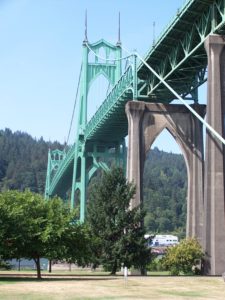 The St. Johns Bridge is unquestionably the crown jewel of Portland bridges. However, it is often overlooked by tourists because it is located several miles north of downtown Portland. It is also difficult to reach public transportation. Even so, Portland’s only suspension bridge is the worth the time it takes to visit. The best place to view the bridge is from Cathedral Park, located below the east side of the bridge. The park gets its name from the Gothic support structures, a style which matches the two main towers. From the Cathedral Park, you can view the bridge against the green backdrop of Forest Park. You can also go right to the base of the east tower and stare 400 feet straight up to the top of the tower.
The St. Johns Bridge is unquestionably the crown jewel of Portland bridges. However, it is often overlooked by tourists because it is located several miles north of downtown Portland. It is also difficult to reach public transportation. Even so, Portland’s only suspension bridge is the worth the time it takes to visit. The best place to view the bridge is from Cathedral Park, located below the east side of the bridge. The park gets its name from the Gothic support structures, a style which matches the two main towers. From the Cathedral Park, you can view the bridge against the green backdrop of Forest Park. You can also go right to the base of the east tower and stare 400 feet straight up to the top of the tower.
